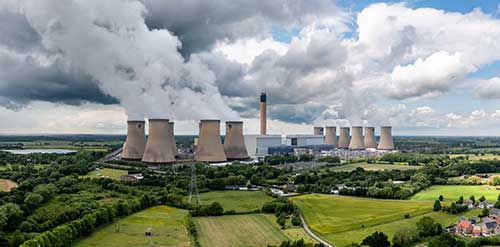Hyundai Motorstudio Senayan Park
Hyundai Motorstudio Senayan Park
Newsroom
-
9 Carbon Emission Reduction Programs in Indonesia and the Reasons
- Hyundai Motorstudio Senayan Park 2022.07.04
-
In fact, the government has been aggressively implementing various carbon emission reduction programs in Indonesia. Not only collaborating with domestic private parties, the carbon emission reduction program also partners with various international parties.
Let's learn what programs the government has implemented to reduce carbon emissions in the archipelago. Read on, come on!
1. Industrial sector
Based on the Bali Road Map 2007 and Kyoto Protocol 1997, Indonesia implemented the National Action Plan (RAN) to reduce carbon emissions by up to 26% with its own efforts. However, if it is assisted by international parties, it must reach the 41% target.
Meanwhile, the industrial sector is committed to reducing carbon emissions by 1 million tons with their own efforts, and 5 million tons if they receive international assistance. Generally, carbon emissions result from the use of energy, process technology, and industrial waste .
In PP No. 70 Year 2009 requires companies to conduct energy conservation, periodic energy audits, and report conservation results to the relevant officials. In fact, if the carbon emission reduction program is carried out regularly, the government will provide incentives and investment funds for companies.
The industrial sectors that contribute the largest carbon emissions include: textile industry, certain food and beverage industries, fertilizer industry, paper industry, cement industry, steel industry, and ceramics industry.
2. Transportation sector
From the transportation sector, the government has accelerated the carbon emission reduction program with electric vehicles. The Ministry of Energy and Mineral Resources has prepared an SPKLU or Public Electric Vehicle Charging Station. This facility is used to charge electric cars at 28,000 points until 2050.
In addition, electric vehicle infrastructure is also provided such as SPBKLU or General Electric Vehicle Battery Exchange Station. So, people can exchange the battery to make it more economical.
In order to encourage public interest in the electric car market, the government also provides PPnBM tax relief. Electric cars are only subject to a 15% PPnBM tax and free Motor Vehicle Transfers (BBNKB) until 2024.
3. Building construction
The progress of urban infrastructure development will continue to develop over time. Therefore, the government implements aspects of comfort and energy saving. Management of urban planning buildings must contribute to the carbon emission reduction program .
For example, infrastructure development such as traditional markets, flats, stadiums, as well as renewable energy generators, and waste management sites. All these development concepts must adopt the principles of green building .
4. Household sector
Carbon emission reduction programs also exist in the household sector. In the form of the application of electrical power efficiency such as LED lights, air conditioners, and other household electronic equipment. The government is aggressively making persuasive appeals, such as "Save Electricity, Save Costs."
In addition, the government also provides education or training to the wider community to process household waste into eco -enzymes or waste enzymes. Eco enzyme is a liquid containing disinfectant produced from the fermentation of household waste or kitchen waste. For example fruit skin, vegetable residue, and others.
5. Renewable energy
The government runs a solar panel program or Rooftop Solar Power Plant (PLTS Atap) as an alternative energy source . This program will be implemented on a small or large scale in various regions throughout Indonesia.
6. Non-fossil fuel
As is known, fossil fuels such as oil and coal can produce carbon emissions and are limited in number. Therefore, the government encourages people to choose biodiesel or bio-gasoline which is more environmentally friendly .
7. Public Street Lighting
Public Street Lighting is one of the public facilities that absorbs large amounts of electrical energy. Since 2016, the government has carried out energy-saving activities for city lighting. You do this by using energy-saving lamps that are equipped with a smart system and metering program.
With metering, each PJU panel will have a kWh-meter. Meanwhile, the lamp uses LEDs which are more energy efficient. As a result, this activity was able to reduce electricity consumption by up to 78% and is one of the successful carbon emission reduction programs .
8. Waste management
Where there are residential areas, there must be trash. In almost every sub-district, the government provides a TPA (Final Disposal Site) equipped with a waste management system. In fact, some of them are able to process waste into electrical energy which is distributed to residents' homes for free.
9. Forestry sector
Not only forest reforestation programs, blue carbon is also an effective carbon emission reduction program. Blue carbon is a kind of carbon emission that is absorbed by the ocean and coastal areas. Such as mangrove forests, seagrass beds, swamp areas, and so on.
In Indonesia, blue carbon has the potential to be developed by improving mangrove forests. Given that Indonesia is an archipelagic and maritime region, it can capture carbon emissions well. Since 2020, more than 80,000 hectares of mangrove forest have been planted with trees. Meanwhile, the Ministry of Maritime Affairs and Fisheries' target is 600,000 hectares of mangrove forest by 2024.
We hope you enjoy this information about the carbon emission reduction program carried out by the Indonesian government. As good citizens, we need to be ready to support and implement these programs for the preservation of our beloved planet earth. How about you, are you ready to support the carbon emission reduction program?




